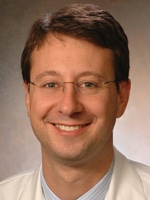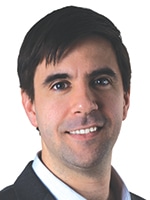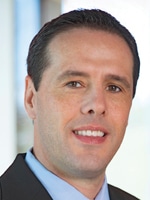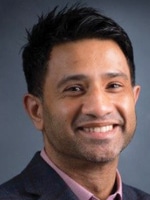Roundtable on regulation, AI, making the most of the sample
May 2022—Next-generation sequencing—the worries, the wins, and what’s new. That’s what came up when CAP TODAY publisher Bob McGonnagle led an NGS-focused roundtable on March 14. With him were Jeremy Segal, MD, PhD, of the University of Chicago; Pierre Del Moral, PhD, MBA, and Fiona Nohilly of Illumina; Sohaib Qureshi, PhD, of Thermo Fisher Scientific; and Andy Johnson, DPhil, of Janssen. Here’s what they had to say.
CAP TODAY’s guide to NGS systems begins here.
Jeremy Segal, in the past year what events have occurred in the field of NGS that may have been surprising, or not surprising because they’re part of the natural evolution of this technology in cancer care?
Jeremy Segal, MD, PhD, director, genomic and molecular pathology, and associate professor, University of Chicago: What worries me going forward is what will happen with the FDA regulation of our tests and what it means in terms of requiring FDA-approved instruments. There’s a big push to change the way our tests are regulated and overseen and in a way that is frightening to people who run academic hospital laboratories.
A lot of your testing is what we could call laboratory-developed tests, correct?
Dr. Segal: Yes.
Pierre Del Moral, from your perspective in industry is that an issue that worries you?
Pierre Del Moral, PhD, MBA, associate director of clinical marketing oncology testing, Americas, Illumina: As a solution provider we need to be adaptable to what the FDA does and says. The oversight may prevent some flexibility. The space is evolving rapidly, so having more stiffness in the process may not yield to the advances the field is looking for.
Sohaib Qureshi, can I get a quick comment from you?
Sohaib Qureshi, PhD, director of product management, instrumentation, clinical NGS division, Thermo Fisher Scientific: Ambiguity around oversight and changes to current regulations are concerning for both customers and solution providers. We need to make sure we’re adapting and providing solutions for laboratory-developed and in vitro diagnostic tests.

Dr. Segal
Jeremy, is this something new or is it a return of something that is part of the environment?
Dr. Segal (University of Chicago): There’s an active effort now to pass the VALID legislation [Verifying Accurate Leading-edge IVCT Development], and people are trying to attach it to the next Medical Device User Fee Amendments coming up. If they attach it, it will not be voted down. If it is not attached, we have a chance to be involved in the process.
The tests and the technology change rapidly, and regulators are concerned that everything is like the Wild West. I don’t see it that way. What we have done in terms of creating tests and a national infrastructure for tests over the past decade has been remarkable—what has been created, what we do daily, how it has changed the way pharmaceutical companies develop and trial their drugs. Everything about cancer testing, treatment, and management has changed incredibly over 10 years. This amazing transformation of our field over the past decade is a testament to the power of the LDT pathway to enable new discoveries to be translated efficiently into care. So we don’t feel like we’re the problem; in fact, we feel like we have been the solution. But the LDT pathway is under constant—and I believe misguided—attack, and what they aim to impose on us will be terribly damaging to our laboratories and more importantly to our future patients. The problem is especially severe in the academic laboratory community—some of our labs have 200 LDTs on their books and no way to transition to a future under VALID.
This legislation, should it pass, could put your efforts in jeopardy and harm patient care, no question in your mind?
Dr. Segal (University of Chicago): The VALID proposal is to grandfather in every LDT that currently exists, but as far as my reading of it, no updates to existing LDTs will be allowed. And all new assays will need to be on FDA-approved instruments, which typically don’t exist when new technologies become available. The biggest problem is how this will affect tomorrow’s technology. Someday soon another disruptive technology will emerge that will allow us to do all sorts of new things, and we’re going to learn—just like with next-gen sequencing—a lot about cancer and genetic disease. People will want to use it to support care, and what happens if there’s no mechanism for doing so in a time-sensitive manner? It will take years for an FDA-approved device to be made. Every new product is marketed as an investigational tool first, and then companies have to plan how they will make the transition to manufacturing of FDA-approved devices. It’s a multi-year process of trying to strategize. That’s multiple years that patients can’t wait.
I don’t understand the thought process behind pushing for a new system that disallows the rapid integration of new science into medical care. And it’s not as if we don’t support increased standards—we would be happy with increased stringency. But treating us like national manufacturers and requiring us to go through a multimillion-dollar, full FDA process for each LDT just does not comport with reality.
The VALID Act represents a certain meeting of minds between industry and people who wanted LDTs; it was seen as kind of a middle way a number of years ago. But we’ll have to see what happens. It’s hard to imagine how the Cancer Moonshot initiative would be successful without laboratory-developed tests.
Dr. Segal (University of Chicago): We have to have a system that allows for safety and doing things the right way. It has to allow for rapid translation of new discoveries into diagnostics. The FDA is more concerned about risk mitigation than it is about making sure patients have the technology available to them.

Dr. Johnson
Andy Johnson, you have important drugs that depend on the detection of genetic markers often in what one might call a low percentage of presenting patients. Doesn’t that make next-gen sequencing a critical technology for Janssen as it looks at drugs?
Andy L. Johnson, DPhil, integrated evidence team lead, solid tumor targeted therapy U.S. medical affairs, oncology, Janssen Scientific Affairs: Yes. The approvals in exon 20 insertion mutations and KRAS mean the field has reached a threshold where NGS provides the most value to patients in terms of being able to identify the most patients with a driver mutation in the least amount of time, with the least amount of tissue, and hopefully the least amount of cost overall. The value that comes with NGS makes a lot of sense.
Do your portfolio development colleagues understand that many of these drugs are targeted therapies that can’t exist in the marketplace without a detection technology like NGS?
Dr. Johnson (Janssen): Yes. It goes into our portfolio and development planning. We need to celebrate when the right patient gets the right treatment, and that comes when a patient receives a comprehensive analysis on their tumor.
We’re expanding our precision medicine and targeted therapies, especially within solid tumors. The development of the testing to find mutations and therapies have to go hand in hand. We can’t treat patients if we haven’t found the mutation.

Dr. Del Moral
Pierre, I assume that means the demands you face as a company for platforms and software are increasing all the time?
Dr. Del Moral (Illumina): Yes. The democratization of NGS is tremendous. The acceptance curve is evolving rapidly—the ease of use of the technologies, the incorporation of comprehensive genomic profiling that has DNA and RNA content, that can simultaneously assess all variant classes, increase the diagnostic yield, look into complex signatures such as tumor mutational burden and microsatellite instability, look at RNA for detection of splice variants, known and unknown fusion partners, and getting patients the therapy that matches their tumor profile. HEOR [health economics and outcomes research] or real-world data showcases how NGS has improved the outcome for patient testing along with what pharmaceutical companies are doing.
There’s been in the past couple of years a tremendous uptake in NGS technology from tissue and liquid biopsy. COVID has also improved the uptake of liquid biopsy testing.
Every group I speak to is talking about serious shortages in staffing in laboratories, including of pathologists, PhDs, programmers, et cetera. Jeremy, are you seeing staffing shortages and difficulties?
Dr. Segal (University of Chicago): It’s certainly gotten harder. The number of resumes that come in for the positions we post is fewer than we used to see, and it takes longer to find someone. As an example, we have someone for a research and development position whom we have wanted to bring in for months. But because of her visa issues, she’s stuck in Vietnam, and she can’t get an appointment with her embassy because of COVID. Fewer people from other countries want to come here to work because of the last administration’s policies. COVID-related embassy problems are a factor. The inflow of the talented people we need has certainly seemed to slow down.
Between our labs here we have four bioinformatician positions, and recently we were down to one individual and had three empty positions. We’re starting to fill those now but it isn’t easy.
Andy, does the staffing shortage make everybody’s job a little harder?
Dr. Johnson (Janssen): Because things continue to get more complex in terms of the scientific and clinical questions we’re answering, it would have been hard regardless of staffing. Given the changes that have occurred the past few years—what Jeremy said about global movement of people and trying to bring people in—I can see how it would make things harder.
It highlights the need for operational simplicity and efficiency, trying to implement upfront work and reflex testing so less effort is needed from the clinicians, pathologists, and nurses and things can flow through more efficiently, including getting testing data into the EHR so it’s at everybody’s fingertips and is more searchable. We can develop new technologies from the scientific side, but we need to simplify user interfaces by enlisting the skills of graphic designers to help get the data to the people who need it.
Dr. Segal (University of Chicago): We have something going for us in the molecular next-gen lab. It is seen as emerging technology, and young people are interested in the field because they see it growing.
We face worry over the coming years on the cytogenetics side. People who are in the field have concerns that it will be replaced by optical geomapping or sequencing technologies or something else. People who are training in laboratory genetics and genomics programs are looking for jobs that have molecular components. Nobody who’s coming out of that training wants a cytogenetics-only job. Most of the technologists in cytogenetics are aging and more of the younger techs are going into things like molecular. People are worried about being able to find cytogeneticists; there are so many open positions now, it’s concerning.
There’s a shared perception that the quality of cancer diagnostics and care is bifurcating. There’s always been a difference between academic and community practices, but that gap seems to be widening. Jeremy, do you share that perception?
Dr. Segal (University of Chicago): That’s probably true. At our center we are doing complete genomic profiling for 100 percent of our lung cancer patients. But from the community, you hear the numbers are 40 percent, and you wonder how that can be true. Five years ago it might have been a similar percentage for both places. So many patients aren’t getting it and the reasons are many-fold, and it’s going to take more work to learn about the issues and probably increased effort at education.

Dr. Qureshi
Sohaib, what’s the view from Thermo Fisher?
Dr. Qureshi (Thermo Fisher): I agree with Jeremy that there’s probably a lot of differentiation in the use of NGS in academic medical centers versus more regional, community care settings. The academic medical centers that are setting themselves apart have been there from the beginning, so they have the expertise in-house, the resources, and the funding. As you go into communities with smaller hospitals, there are challenges with resources, access to trained personnel, and availability of novel technologies that can improve patient outcomes. Our mission in NGS has been to make NGS accessible to a broad spectrum of labs with solutions tailored for clinical labs. The adoption of NGS in community care settings is increasing rapidly as labs get access to technology that works in their settings.
Pierre, can you speak to the same question?
Dr. Del Moral (Illumina): The gap is narrowing because there are already send-out options for oncology testing. There are service labs that provide the opportunity for their patients to be tested for comprehensive genomic profiling, for example. We also see hospital networks implementing that type of testing in-house and community oncology moving toward that.
The reason for the discrepancy is often access. It could be access to testing in-house. For example, as a solution provider we’re working with automation vendors to automate our solutions and provide the most flexibility to implement NGS testing in-house. Access could also mean on the payer side—who’s going to pay for that test? I also think of access to clinicians, where we’re investing a lot in clinical decision support and software. How can a general oncologist interpret the data without the formal genomic training and be able to say, I’m going to provide the best therapy to my patient. This access piece is going to be important in narrowing the gap.
 CAP TODAY Pathology/Laboratory Medicine/Laboratory Management
CAP TODAY Pathology/Laboratory Medicine/Laboratory Management
